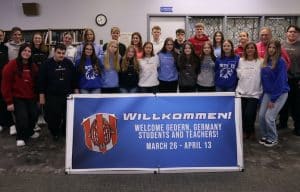Port district growing
The Kaskaskia Regional Port District is experiencing substantial growth as nearly $37 million in grants has been approved for a range of projects.
Speaking on these many projects was KRPD General Manager Edward Weilbacher, who also provided an overview and history of the organization during a recent press conference.
Weilbacher noted that the district is rather unique as most ports only have one large footprint. In contrast, KRPD has five locations: the Fayetteville Terminal, Evansville Grain Terminal, the Kellogg Dock along the Mississippi River, and KRPD Dock No. 1 and Dock No. 2 located near New Athens and Baldwin, respectively.
He emphasized the importance of cargo in the district’s ports, specifically describing how Dock No. 1 – which now ships the nearby power plant the byproducts gypsum and fly ash – previously shipped four million tons of coal at its peak only for that figure to shrink come 2000.
“When the coal market collapsed and they no longer shipped coal, we were down to a total of 400,000 tons on the Kaskaskia River, and that was in the year 2000,” Weilbacher said. “So there was talk at that time of ‘Do we need to maintain the lock and dam?’ And that’s why the Lower Kaskaskia Stakeholders got formed was to show the public support for the river.”
Regarding the announced grants, the $37 million is divided between about a dozen projects, all in various stages of planning and development.
Among the more notable projects is a proposed pipeline from the Fayetteville Terminal to Scott Air Force Base.
Weilbacher explained that a previous assessment of domestic military bases highlighted two major deficiencies in the base – a lack of both a long runway and redundant fuel supply – which could impact the base’s future support.
While the runway issue was addressed by St. Clair County with the construction of MidAmerica Airport, the fuel matter was put on the back burner as a pipeline running from Wood River or Roxana to the base was entertained but ultimately shelved as it would stretch for 36 miles through some rather populated areas.
Weilbacher said the Fayetteville pipeline was first entertained as part of a recent port district strategic plan. This pipeline would stretch only 18 miles through much more rural terrain.
“We then started to see if there was still interest and a need, and as we reached out to the base and to others in the area, they all felt yes, it was still needed,” Weilbacher said. “But they weren’t sure how to go about it, and they encouraged the port and others to take the lead.”
The grant of $350,000 was acquired earlier in September in order to pay for a feasibility study on the project. Weilbacher said the district is now advertising for qualification requests for firms which close on Dec. 4.
From there, he said interviews would take place among four of the selected firms in the hopes of a contract in late January.
Weilbacher attested to the benefits of a fuel pipeline, noting it would act as a boon for both the port district and Scott Air Force Base which he described as one of the biggest employers in the area.
“Anytime you can increase cargo on the river, it helps us from a standpoint of just cargo,” Weilbacher said. “We’re measured with the Corps of Engineers how much cargo we have on the river. There’ll be some jobs created as a result of the terminal at Fayetteville if it’s built. In addition, it protects the base. It keeps the base in a position where it can compete against other facilities when they do another round of evaluations. It helps the base in their scoring.”
While the pipeline feasibility study stands out among the list of projects and their grants, some of the more miscellaneous projects include upgrading the Evansville Water Street facility – a $250,000 grant – and installation of railroad crossing signals and gates at two locations on Baldwin and Winter Roads – a $736,250 grant.
By far the biggest collection of projects involves KRPD Dock No. 2. One of these projects is the demolition of fertilizer domes and an old, obsolete conveyor as Gateway FS seeks to expand.
Other KRPD Dock No. 2 projects are centered on improving efficiency and cargo volume, with the addition of a second entrance road, a double track rail under an overhead crane and the addition of eight shuttle cars.
Weilbacher also mentioned the addition of storage space which seems to be much needed.
“Our second entrance road going into KRPD No. 2 will get built along with two laydown yards to store coiled steel because we’ve had a problem where barges were not being unloaded,” Weilbacher said. “They were sitting on the water for over five months at a time because we didn’t have a place to go with it at the terminal. And so this is going to allow us to store more on-site.”
There are also two projects set at KRPD Dock No. 1: the addition of a second rail loop along with an upgrade to the rail yard and corridor.
As he spoke about KRPD Dock No. 1, Weilbacher noted the district hopes to add two million tons of cargo to the 1.5 million tons the terminal shipped last year, noting that, “When people talk about increasing cargoes on a river or at a terminal or at a port, they usually talk in terms of 100,000 tons, maybe.”
Weilbacher also noted that there are two projects which were denied grants, a south dock at KRPD Dock No. 2 and an electric rail connection between KRPD Dock No. 1 and the Prairie State Energy Campus – though he added the district plans to pursue these grants again in the future.
Regarding the grants specifically, KRPD Board Chairman George Obernagel noted that while these grants have been approved, much of the actual funds for the projects has yet to make its way to the district.
Weilbacher summarized the impact that the many projects will have on the port district.
“I think there’s a lot of things going on,” Weilbacher said. “This will be the largest expansion of the port since its inception.”






